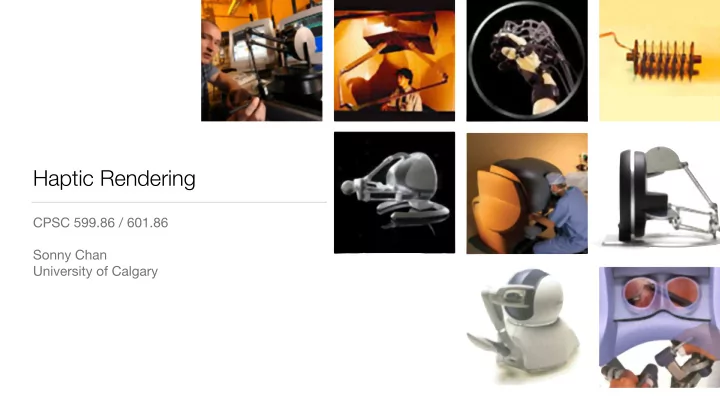

Haptic Rendering CPSC 599.86 / 601.86 Sonny Chan University of Calgary
Today’s Outline • Announcements • Human haptic perception • Anatomy of a visual-haptic simulation • Virtual wall and potential field rendering
Reminder: Friday Labs • Every Friday during the semester, during our regular class time 13:00 – 13:50 in MS 156 - we will start this Friday, Jan. 18 - • I’ll be trying to teach you how to code too! :-)
Course Materials • Visit our course web page for up to date information: handouts, lecture slides, assignments, etc. - http://cpsc.ucalgary.ca/~sonny.chan/cpsc599.86/ - http://cpsc.ucalgary.ca/~sonny.chan/cpsc601.86/ - • Readings will be posted on D2L site
Haptic Perception
somatosensory system cutaneous receptors kinaesthetic receptors Touch Perception
Cutaneous Perception • Inputs from different types of mechanoreceptors embedded in the skin vibration and texture perception - pressure and skin stretch (grasped object) -
Kinaesthetic Perception • Inputs from mechanoreceptors in muscles, tendons, and joints limb position and movement - larger contact forces and loads -
Cutaneous / Tactile Feedback • Devices can be very difficult to realize requires high spatial actuator resolution -
Kinaesthetic Feedback • Key realization: tool-mediated interaction system need only render tool contact forces -
Kinaesthetic Haptic Devices • Driven by two common types of control strategies Impedance-control haptic devices simulate mechanical impedance - Admittance-control haptic devices simulate mechanical admittance -
Impedance vs. Admittance Control • Impedance devices • Admittance devices sensed position sensed force - - commanded force commanded position - -
Impedance vs. Admittance Devices • Impedance haptic devices are cheaper to build - back-drivable - • Admittance haptic devices higher range of forces - requires force sensor ($$$) - generally less common -
Devices for CPSC 599/601 • We will focus on studying - kinaesthetic devices : tool- mediated interaction - impedance control : render forces (impedances) - 3-DOF actuated devices, 3- or 6- DOF sensed
Visual-Haptic Simulation Under the Hood
The Basics • How does a basic visual-haptic simulation work? Avatar Virtual Environment Haptic Interface
The Interface position force
“Haptic rendering is the process of computing and generating forces in response to user interactions with virtual objects.” –J. Kenneth Salisbury [From K. Salisbury et al., Proc. Symposium on Interactive 3D Graphics , 1995.]
Simulation Components Simulation Visual rendering Simulation engine F d X S, X Haptic Collision Force Graphics Video device detection response engine F d F r Control algorithms Haptic rendering [From K. Salisbury et al., IEEE Computer Graphics & Applications 24(2), 2004.]
In this course… Simulation Visual rendering Simulation engine F d X S, X Haptic Collision Force Graphics Video device detection response engine F d F r Control We focus on the haptic algorithms rendering component. Haptic rendering
The Virtual Environment Simulation Simulation • representations of virtual objects engine • real-time simulation of physical F d behaviour X S, X Collision Force detection response • geometric modelling (CPSC 589/689) and computer animation (CPSC 587/687)
Haptic Device • We will treat the device as a X S, X “black box” Haptic Collision device detection - We will crack one open near the end of the semester F r • Take the online “Introduction to Haptics” course at Lagunita to learn more!
Visual Rendering Visual rendering • Given a virtual environment, Simulation engine render its state on the screen (in real time) F d X S, X • We will let CHAI3D do this for us Force Graphics Video response engine • CPSC 453, F d CPSC 591/691
Haptic vs. Visual Rendering Visual Rendering Haptic Rendering
Bi-Directionality • Bi-directional information flow is a distinguishing feature of haptic interfaces • This has many consequences that we will visit in later classes Haptic Rendering
Potential Fields
Recall the hardware-software interface: position force
Starting Simple • A plane is one of the simplest virtual environments we can conceive and render • How can we render such a F = f ( x ) = ? “virtual wall”?
Virtual Walls • The simplest virtual environment: a linear spring in 3D • Can be used to study stability • Useful building block for more complex virtual environments and interactions
Virtual Wall Algorithm x ( if x > 0 − kx F ( x ) = 0 otherwise F
Virtual Wall Stiffness harder materials • Stiffness (k) affects how the virtual wall feels | F | softer materials avatar F = − kx x
Another Shape • What is the simplest way to render a circle or a sphere?
Potential Fields • The term potential field is borrowed from physics / mechanics • Force is a vector field gradient of potential ~ F = r U • We normally just skip to defining force field
Why Potential Fields? • They make intuitive sense (3D springs) • They are easy to compute • ... but with simplicity comes limitations
Summary • Human haptic perception kinaesthetic feedback and impedance devices - • Anatomy of a visual-haptic simulation we’ll focus on the haptic rendering aspect of things - • Virtual wall and potential field rendering the tools you need for programming assignment #1 -
Recommend
More recommend